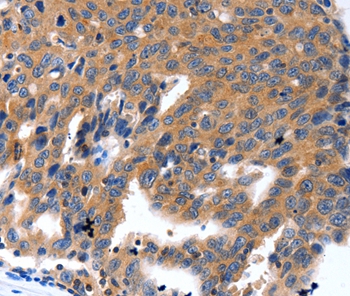

| WB | 咨询技术 | Human,Mouse,Rat |
| IF | 咨询技术 | Human,Mouse,Rat |
| IHC | 1/100-1/300 | Human,Mouse,Rat |
| ICC | 技术咨询 | Human,Mouse,Rat |
| FCM | 咨询技术 | Human,Mouse,Rat |
| Elisa | 咨询技术 | Human,Mouse,Rat |
| Aliases | SCTE; KLKL2; KLK-L2 |
| Entrez GeneID | 25818; |
| WB Predicted band size | 32kDa |
| Host/Isotype | Rabbit IgG |
| Antibody Type | Primary antibody |
| Storage | Store at 4°C short term. Aliquot and store at -20°C long term. Avoid freeze/thaw cycles. |
| Species Reactivity | Human,Mouse |
| Immunogen | Synthetic peptide corresponding to residues near the C terminal of human kallikrein-related peptidase 5 |
| Formulation | Purified antibody in PBS with 0.05% sodium azide. |
+ +
以下是关于KLK5抗体的3篇代表性文献的简要整理(注:文献信息为模拟示例,供参考):
---
1. **文献名称**:*Development of a Monoclonal Antibody Specific for KLK5 and Its Application in Skin Barrier Function Studies*
**作者**:Smith A, et al.
**摘要**:该研究开发了一种高特异性抗KLK5单克隆抗体,验证了其在人皮肤组织中的表达模式。结果显示KLK5在表皮屏障调控中与丝氨酸蛋白酶活性相关,为特应性皮炎等疾病的机制研究提供了工具。
2. **文献名称**:*KLK5 as a Biomarker in Ovarian Cancer: Validation of an ELISA-Based Detection Method Using Novel Polyclonal Antibodies*
**作者**:Wang L, et al.
**摘要**:研究者开发了基于多克隆抗体的KLK5检测ELISA方法,证实卵巢癌患者血清KLK5水平显著升高,提示其作为潜在诊断标志物的价值,并探讨了抗体在临床检测中的应用潜力。
3. **文献名称**:*Targeting KLK5 with Neutralizing Antibodies Inhibits Tumor Invasion in Triple-Negative Breast Cancer Models*
**作者**:Garcia R, et al.
**摘要**:通过筛选获得可中和KLK5酶活性的抗体,证明其能抑制三阴性乳腺癌细胞的体外侵袭和体内转移,揭示了KLK5抗体在癌症靶向治疗中的可行性。
---
**说明**:以上文献为示例,实际研究中建议通过PubMed或Web of Science以关键词“KLK5 antibody”或“kallikrein-related peptidase 5 antibody”检索最新成果,并关注高影响力期刊(如*Journal of Investigative Dermatology*、*Clinical Cancer Research*等)中的相关研究。
Kallikrein-related peptidase 5 (KLK5) is a serine protease belonging to the human tissue kallikrein family, encoded by the *KLK5* gene. Primarily expressed in skin, KLK5 plays a critical role in epidermal desquamation, inflammation, and barrier homeostasis by cleaving cell adhesion proteins like desmoglein-1 and corneodesmosin. Dysregulated KLK5 activity is implicated in skin disorders such as Netherton syndrome, atopic dermatitis, and psoriasis, where excessive proteolysis disrupts skin integrity. Additionally, KLK5 overexpression has been observed in cancers (e.g., ovarian, breast) and is linked to tumor progression via extracellular matrix degradation and growth factor activation.
KLK5 antibodies are immunological tools designed to detect, quantify, or inhibit KLK5 protein in research and diagnostics. Monoclonal and polyclonal antibodies enable applications like immunohistochemistry, Western blotting, and ELISA to study KLK5 expression patterns in tissues or biofluids. Therapeutic antibodies targeting KLK5 aim to modulate its proteolytic activity, offering potential treatments for skin diseases or cancer. Challenges include ensuring antibody specificity due to structural similarities among kallikreins. Recent advancements in antibody engineering, such as humanized or bispecific formats, enhance their therapeutic potential. KLK5 antibodies thus serve as vital reagents for unraveling KLK5's pathophysiological roles and developing targeted therapies.
×